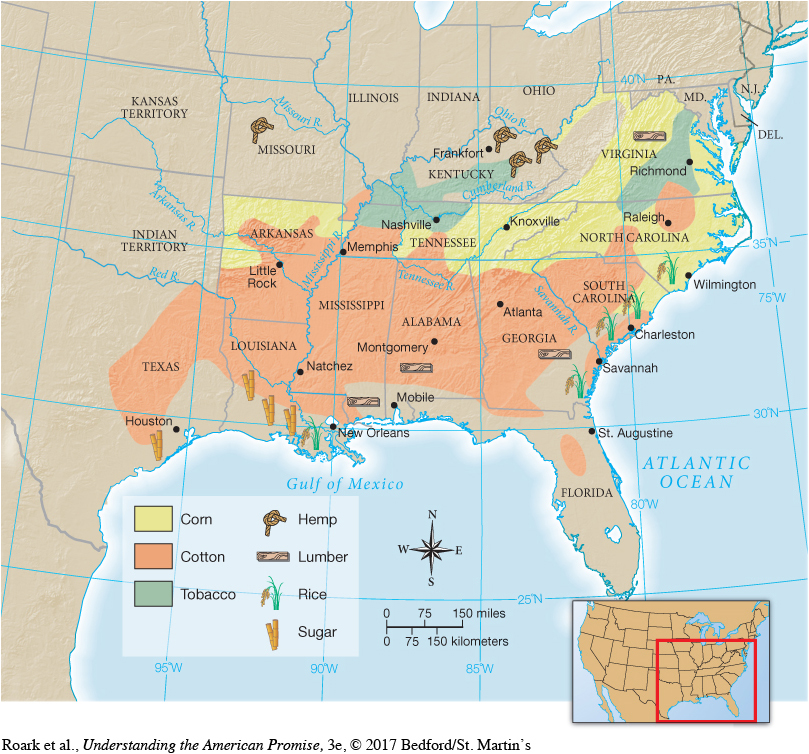The Plantation Economy
As important as slavery was in unifying white Southerners, only about a quarter of the white population lived in slaveholding families. Most slaveholders owned fewer than five slaves. Only about 12 percent of slaveholders owned twenty or more, the number of slaves that historians consider necessary to distinguish a planter from a farmer. Despite their small numbers, planters dominated the southern economy. In 1860, 52 percent of the South’s slaves lived and worked on plantations. Plantation slaves produced more than 75 percent of the South’s export crops, the backbone of the region’s economy. While slavery was dying elsewhere in the New World (only Brazil and Cuba still defended slavery at midcentury), slave plantations increasingly dominated southern agriculture.
[[LP Photo: P13.02 The Fruits of Amalgamation/

The South’s major cash crops—tobacco, sugar, rice, and cotton—grew on plantations (Map 13.2). Tobacco, the original plantation crop in North America, had shifted westward in the nineteenth century from the Chesapeake to Tennessee and Kentucky. Large-scale sugar production began in 1795, when Étienne de Boré built a modern sugar mill in what is today New Orleans, and sugar plantations were confined almost entirely to Louisiana. Commercial rice production began in the seventeenth century, and like sugar, rice was confined to a small geographic area, a narrow strip of coast stretching from the Carolinas into Georgia. [[LP Map: M13.02 The Agricultural Economy of the South, 1860 – MAP ACTIVITY/

But by the nineteenth century, cotton reigned as king of the South’s plantation crops. Cotton became commercially significant in the 1790s after the invention of a new cotton gin by Eli Whitney (see “Agriculture, Transportation, and Banking” in chapter 9). Cotton was relatively easy to grow and took little capital to get started—just enough for land, seed, and simple tools. Thus, small farmers as well as planters grew cotton. But planters, whose extensive fields were worked by gangs of slaves, produced three-quarters of the South’s cotton, and cotton made planters rich.
> PLACE EVENTS
IN CONTEXT
What was the relationship between the North’s economic transformation in this period and the increasing importance of cotton agriculture in the South?
Plantation slavery also enriched the nation. By 1840, cotton accounted for more than 60 percent of American exports. Most of the cotton was shipped to Great Britain, the world’s largest manufacturer of cotton textiles. Much of the profit from the sale of cotton overseas returned to planters, but some went to northern middlemen who bought, sold, insured, warehoused, and shipped cotton to the mills in Great Britain. As one New York merchant observed, “Cotton has enriched all through whose hands it has passed.” As middlemen invested their profits in the booming northern economy, industrial development received a burst of much-needed capital. Furthermore, southern plantations benefited northern industry by providing an important market for textiles, agricultural tools, and other manufactured goods.
The economies of the North and South steadily diverged. While the North developed a mixed economy—agriculture, commerce, and manufacturing—the South remained overwhelmingly agricultural. Year after year, planters funneled the profits they earned from land and slaves back into more land and more slaves. With its capital flowing into agriculture, the South did not develop many factories. By 1860, only 10 percent of the nation’s industrial workers lived in the South. Some cotton mills sprang up, but the region that produced 100 percent of the nation’s cotton manufactured less than 7 percent of its cotton textiles.
Without significant economic diversification, the South developed fewer cities than the North and West. In 1860, it was the least urban region in the country. Whereas nearly 37 percent of New England’s population lived in cities, less than 12 percent of Southerners were urban dwellers. Because the South had so few cities and industrial jobs, it attracted small numbers of European immigrants. Seeking economic opportunity, not competition with slaves (whose labor would keep wages low), immigrants steered northward. In 1860, 13 percent of all Americans were born abroad. But in nine of the fifteen slave states, only 2 percent or less of the population was foreign-born.
Northerners claimed that slavery was a backward labor system, and compared with Northerners, Southerners invested less of their capital in industry, transportation, and public education. But few Southerners perceived economic weakness in their region. Indeed, planters’ pockets were never fuller than in the 1850s, thanks to the South’s near monopoly on cotton, the hottest commodity in the international marketplace. Planters’ decisions to reinvest in cotton ensured the momentum of the plantation economy and the political and social relationships rooted in it.
> QUICK REVIEW
Why did the nineteenth-century southern economy remain primarily agricultural?
Understanding the American Promise 3ePrinted Page 350
Section Chronology